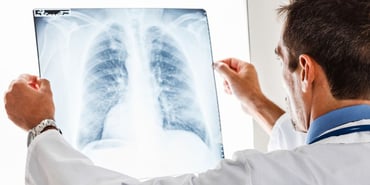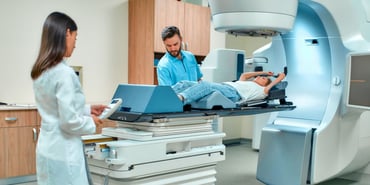
Lung cancer affects both men and women, but it often does not show symptoms until it is advanced. Most cases are found when treating other health issues. Fortunately, now there is a lung cancer screening option for high-risk individuals, helping with earlier detection and better outcomes.
What Is Lung Cancer Screening?
Screenings are routine tests that doctors use to check for diseases in the body. Lung cancer is one of several types of cancer that doctors can screen for. By doing this, cancer can be caught before symptoms appear and before cancer spreads to other organs. This makes treatment easier with a higher success rate.
Low-dose CT Scan of the Chest
A low-dose CT scan (LDCT) is the imaging test used to look at the lungs for any abnormalities. Low doses of radiation create a series of detailed images of the lungs. A computer connected to the X-ray equipment generates high-quality, cross-sectional pictures showing lung and nodules or areas of concern. Low-dose CT scans are more advanced than standard X-rays and provide better detail of the inside of the body.
Lung cancer screening CT scans are outpatient, so you do not need to stay in the hospital. They are quick, safe, and painless, performed even before lung cancer is suspected. The tests are non-invasive and do not require anesthesia or surgery.
Who Should Be Screened for Lung Cancer?
Certain risk factors raise the chances of developing lung cancer, including environmental and lifestyle choices. While the disease can affect anyone, not everyone qualifies for screening. Currently, it’s only recommended for those with the highest risk level. The U.S. Preventive Services Task Force (USPSTF) defines the criteria to qualify for lung cancer screening. You must meet all of the following conditions:
- You are between 50 and 80 years old,
- You have a “20-pack-year” smoking history,
- You currently smoke or have quit within the last 15 years.
The CDC defines a "pack-year" as smoking one pack of cigarettes daily for a year. For example, a 10-pack-year history could come from someone who smoked a pack a day for 10 years or two packs a day for five years.
It is best to discuss your lung cancer risk with your doctor to see if screening is right for you. Screening is not recommended for everyone because of potential risks linked to repeated exposure to low doses of radiation.
Most insurance plans, including Medicare, cover lung cancer screenings if you meet the criteria.
Benefits of Lung Cancer Screenings
The main benefit of lung cancer screening is early detection, which can significantly improve outcomes for this disease. Treatments can start sooner than if you wait for symptoms to appear, which usually means the cancer is more advanced and harder to treat. Patients in the early stages may need fewer treatments, sometimes just surgery, while those in later stages might require multiple treatments over a longer period of time.
Risks Associated with Lung Cancer Screening
There are a few minimal risks associated with lung cancer screening. In general, the benefits far outweigh the risks. However, you should be aware of the following if you qualify for lung cancer screening:
- Increased Radiation Exposure - Chest X-rays and Low-Dose Spiral CT scans can increase a patient’s risk of cancer. These screenings can potentially harm healthy tissue.
- False Positives and False Negatives - Some tests may show abnormal results (false positives) when cancer is absent. This can cause unnecessary anxiety and lead to follow-up tests or biopsies, which have their own risks. Additionally, there is a chance that cancerous tumors could be missed during a screening (false negatives), delaying necessary medical care even when other lung cancer symptoms are present.
- Overdiagnosis - Overdiagnosis can become a problem when a physician identifies a cancerous tumor that may have never caused issues or become life-threatening. This can lead to unnecessary and invasive treatments, affecting the patient’s quality of life.
Deciding If Lung Cancer Screening Is Right for You
If you think you may be a candidate for lung cancer screenings, please talk with your doctor. Together, you can decide whether screening is the best option for you and, if so, when you should start.
While lung cancer screening can indicate the presence of cancer, it cannot provide a definitive diagnosis. If something suspicious is detected in your scans, your doctor will recommend a biopsy, which involves removing a tissue sample for testing. A biopsy is the only method to confirm whether it is indeed cancer.
Related Reading: Are Lung Nodules Cancerous?
If you are diagnosed with cancer, you will need to meet with an oncologist who will conduct additional tests to identify the specific type of lung cancer and its stage.
Lung Cancer Treatment Specialists in Portland and Vancouver
If a cancer screening test leads to a lung cancer diagnosis, the Compass Oncology team of skilled cancer specialists is ready to help you. Our dedicated group of physicians and supportive care providers will determine the best treatment options for you while also being committed to your overall mental and emotional wellness. We can also give you a second opinion on a diagnosis and treatment plan.
We have several cancer centers in Portland, OR, and Vancouver, WA. Learn more about the lung cancer specialists at Compass and why you should choose us for your lung cancer care.
Originally published July 2019. Updated March 2025.



